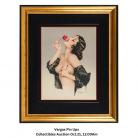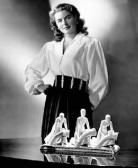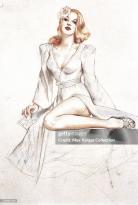Unveiling Beauty: A Timeline of Influential Events in the Creation of "Jeanne (Victory for a Soldier)" by Alberto Vargas
Created by Ishelly Otwani on Fri, 04/05/2024 - 16:14
This timeline provides a sociohistorical context for Alberto Vargas, 1942, Jeanne (Victory for a Soldier).

MLA: Vargas, Alberto. Jeanne (Victory for a Soldier). 1942.
https://www.wikiart.org/en/alberto-vargas/jeanne-victory-for-a-soldier-
1942. Accessed 1 April 2024
Timeline
Chronological table
| Date | Event | Created by | Associated Places | |
|---|---|---|---|---|
| circa. 1900 |
Classical Influence on Alberto Vargas' Pin-Up AestheticAlberto Vargas drew inspiration from classical sculptures, particularly the idealized representations of the feminine form found in ancient Greek and Roman art. This influence is evident in his meticulous attention to anatomical accuracy, graceful poses, and symmetrical compositions, all of which contribute to the timeless beauty and elegance of his pin-up creations. By acknowledging the influence of classical sculpture on Vargas's artistic style, viewers gain a deeper appreciation for "Jeanne (Victory for a Soldier)" and its aesthetic nuances. The painting's harmonious blend of classical beauty standards with contemporary sensibilities reflects Vargas's mastery in bridging the gap between traditional and modern art forms, creating a captivating and enduring portrayal of feminine allure. Explanation of Events' Impact on "Jeanne (Victory for a Soldier)": The reason that I offered that background concerning those three events is that it helps me to explain what "Jeanne (Victory for a Soldier)" was doing socially, culturally, and artistically when Alberto Vargas created it. Vargas's artistic evolution at Esquire Magazine provided him with the platform to refine his signature style, which is prominently displayed in "Jeanne" through its meticulous attention to detail and captivating portrayal of feminine allure. The symbolism of pin-up art during World War II, coupled with Vargas's classical influences, adds layers of meaning to "Jeanne," transforming it from a mere depiction of beauty to a powerful symbol of resilience, unity, and timeless elegance. By delving into these events, viewers can better understand the artistic brilliance behind "Jeanne (Victory for a Soldier)" and appreciate its enduring relevance in the realm of pin-up art.
MLA: McMillan, Meagen. “A Brief History of Pin-up Art: Gil Elvgren.” Heritage Auctions Blog, 9 Jan. 2020, blog.ha.com/a-brief-history-of-pin-up-art-gil-elvgren/. |
Ishelly Otwani | ||
| 1939 to 1945 |
World War II and the Symbolism of Pin-Up ArtDuring World War II, pin-up art played a crucial role in boosting morale and fostering a sense of patriotism among soldiers and civilians alike. These illustrations, often featuring glamorous women in heroic or supportive roles, served as symbols of hope, resilience, and solidarity during a tumultuous period in history. "Jeanne (Victory for a Soldier)" epitomizes this sentiment by depicting a victorious woman embodying the spirit of support for soldiers fighting overseas. Understanding the historical context of World War II and the significance of pin-up art allows viewers to appreciate "Jeanne" beyond its aesthetic appeal. It becomes a symbol of resilience and unity, capturing the collective determination to overcome adversity and uphold the values of freedom and victory.
Team, SOFREP News. “Nose Art of WWII: From Pin-up Women to Patriotic Messages.” SOFREP, 21 Jan. 2022, sofrep.com/news/nose-art-of-wwii-from-pin-up-women-to-patriotic-messages/. |
Ishelly Otwani | ||
| circa. 1940 to circa. 1950 |
Alberto Vargas' Artistic Evolution at Esquire MagazineIn the 1940s and 1950s, Alberto Vargas emerged as a prominent pin-up artist for Esquire Magazine, where he honed his distinctive style characterized by vibrant colors, alluring poses, and meticulous attention to detail. His tenure at Esquire not only solidified his reputation as a master of sensual illustrations but also allowed him to experiment with various techniques that would later define his iconic pin-up artistry. Vargas's time at Esquire is pivotal to understanding "Jeanne (Victory for a Soldier)" as it showcases his ability to capture feminine beauty in a captivating and sophisticated manner. The painting's intricate details, the play of light and shadow, and the overall aura of allure reflect the culmination of Vargas's artistic journey during his Esquire years, making "Jeanne" a testament to his skillful portrayal of seductive aesthetics. |
Ishelly Otwani |



